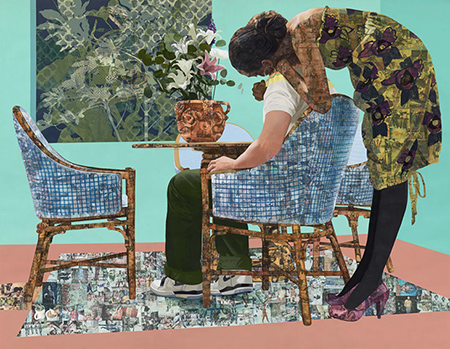
Continuing through July 29, 2023
Over the last decade since I first encountered her work in a London gallery, where I was much impressed with the skill and beauty of her work, I have had numerous opportunities to see Njideka Akunyili Crosby's works. Since then they have only grown more nuanced and sophisticated, as her current exhibition attests.
In “Coming Back to See Through, Again” Akunyili Crosby presents a selection of multi-layered works on paper that juxtapose photographic transfers and painted depictions of interiors and exteriors some with, but many without people. Collectively and individually, these large-scale works on paper suggest a range of periods of time, as well as the possibilities of different worlds, all glimpsed through windows and doorways.
“Blend in — Stand out” (2019) is a large-scale work spanning 95 by 123 inches. The image depicts an interior setting but, true to form, Akunyili Crosby simply suggests the room, with walls and floor presented as flat solid colors. Within this closely cropped space are two figures — a woman hugging a man — seen from the side, four chairs, a rug, and a table with a plant on it. An abstract painting of plants, similar to the flowers in a pot on the table (as well as to other paintings in the gallery), hangs on the wall. Akunyili Crosby's blend of painting and collage is evident in this work with the beautifully collaged elements creating a compelling contrast to the painted areas. While elements of the background — walls and flowers, the seated man's arm, white T-shirt, sneakers and green trousers, as well as the woman's hand and legs — are painted, almost everything else is carefully constructed or overlaid with collaged (transferred) elements that come from both personal and historical sources. Akunyili Crosby's use of collage infuses her works with a sense of history that implies a continuum from past to present and helps to define her characters.
Like “Blend in — Stand out,” “Still You Bloom in This Land of No Gardens” (2021) is a self-portrait. Akunyili Crosby sits on a chair with her young child on her knee outside her home, which is surrounded by vegetation. The interior of the home is visible through an open door. The layered and balanced composition again juxtaposes flat painted areas against painted patterns and collages made from photographic transfers. Seen both in front of and behind mother and child, the mingling of plant life, patterns, and photographic montage both obscures and concretizes the figures. Akunyili Crosby draws from her childhood in Nigeria, the African diaspora, and notions of displacement and identity to weave together a narrative that is at once personal and universal. That the child wears a T-shirt that reads "Black is Beautiful" is visually subtle, yet politically pointed.
Interspersed among the figurative images are works that foreground nature. At first glance, “Dwellers: Cosmopolitan Ones” (2022), “Persistence of Vision: Screen Walls & Fruit Tree” (2022), and “Potential, Displaced” (2021) appear to be images of dense vegetation and architectural details in both solid tones and Akunyili Crosby's signature patterns of transfers. She is interested in the origins and migrations of plants (as well as people), in particular their cultural and historical associations. The green-hued leaves on a tree positioned at the bottom of “Persistence of Vision: Screen Walls & Fruit Tree,” in front of a light-tan screen/wall, are in fact green painted transfers culled from photographs and magazine pages. While seemingly an image of the type of residences built in Nigeria in the 1970s and 80s, Akunyili Crosby connects it to those who inhabited the area.
Akunyili Crosby's layered works can be understood on multiple levels. From afar, they are exteriors, portraits and landscapes that explore issues of family and nature. A closer examination casts them as encyclopedic adventures that integrate past and present, and the geographical locales of Los Angeles and Nigeria. The formal elements of paint and photographic transfer, abstraction and collage elevate the whole into evocative, seductive, engaging artworks that reveal more and more the longer they are observed.
